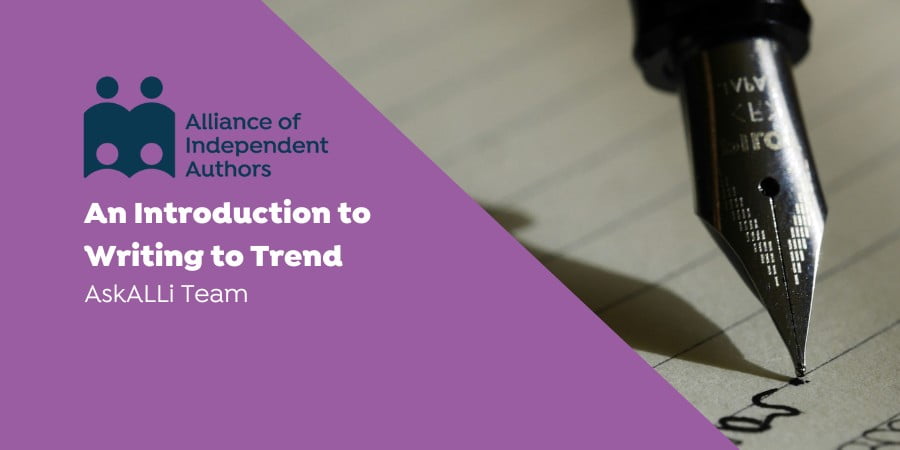
Photo by Aaron Burden on Unsplash
Writing to trend
One big benefit of indie publishing is that it’s up to us, as authors, what genre we write in, what niche we explore and which audience we write for. By undertaking our own research and planning, we can identify opportunities to make the most of emerging trends, and reader interest in them. So today at the Alliance of Independent Authors we're looking at what a ‘trend’ really is, how to identify one that works for you, and how to fulfil the expectations of your readers.
How is a trend different from a genre?
A trend is a specific topic, narrative, or niche that is gaining significant sales within a genre. So, whilst romance may be a genre, monster romance is a current significant romance trend.
Some trends eventually demonstrate longevity by becoming their own sub-genre over time – see paranormal romance. But generally, if you are writing to trend, you are writing to fit the conventions of an emerging niche within a genre that has a ready-made audience looking for more books that suit their current obsession.
If you enjoy studying the writing craft, learning about tropes and narratives, and writing stories that readers are looking for, then writing to trend may be for you.
However… this may not be an approach for those who like to take a lot of time over the publishing steps and refine every beat and word. Writing to trend, particularly if you are looking to write a series, is a speedy process. You need to get your books out while readers are still actively on the search for more to fulfil their needs. With writing to trend, timing is critical.
With that in mind, here are our five steps to writing to trend successfully, along with some top and considerations from ALLi Members and ALLi's own Sacha Black.
1. Where to look first
The first step is to identify the genre you want to explore to find your trend. If you are already writing in a genre that you love, it may be most natural to identify a trend within that genre for your first foray.
Or you may want to take the opportunity to try something completely new and look across other genres for trends to explore. Either way, selecting a genre is the first step to identifying your trend.
Remember, this will be quite a commitment of your writing time, so pick a genre you feel you can write for over a period of time and that you’ll enjoy, so you can stay the distance.
2. Identify your trend
If you think this is for you, now is the time to study your chosen genre to identify a trend within it. Studying the charts is vital, but not just once or twice, you need to study them over time. This is so that you can recognise the market shifts and patterns to spot the elements that occur more frequently — and therefore indicate an upcoming trend.
Think: What storylines, characters, plot-twists, or other themes are starting to sell well? What ideas are consistently beginning to rise to the top right now? What is starting to stick, and will it have an audience you can tap into?
Don’t just look at sales listings, you can also look for trending topics on social media platforms, such as TikTok or Instagram. Think: What is your audience talking about? Which authors are being discussed? What fresh stories or themes are prompting debate amongst readers? Which books keep being posted about? Do you keep hearing a new term or word? What about a trope that keeps getting talked about?
But beware of outliers. These are the one-off concepts that may do well for a short period, or for one specific author, but which do not sustain popularity. Or for trends on the way down, the trends that have already been saturated with books and are about to burn out. The ideal trend is one that has proven success, but still has growing interest from readers.
There are other resources that can help with identifying trends such as Alex Newton's K-Lytics reports, or the Kindletrends reports. Both scrape Amazon for information and use complex analytics to assess what is trending.
3. Learn the trend
Once you’ve found the trend that you feel is ready for new books that you can provide, it's time to study your competitors. You need to know them inside out to fit alongside them and appeal to the same audiences.
This means of course reading the books themselves, for craft, you need to know the patterns, so ask yourself what's the common:
- Book and chapter length
- Point of View
- Tense
- Type of narration (single or dual)
- Size of cast
- Tropes
- Pace and level of description
For marketing you need to do the same exercise but look at the commonalities across:
- Sales descriptions
- Cover colours, styles, shapes and art
- Marketing tone (words and phrases used in copy, as well as colours and images)
- Key words, tags, categories
- Typography
- Research which influencers are talking about this genre or trend
If you're selling wide, then you need to do this research on each of the wide sales platforms to ensure you know how those platforms work and the trends, categories and keywords specific to them which will help your books be found by your target readers.
Titles and covers are so important here too, as they tell the reader what to expect and is the first sign that your book offers what they want. There’s no need to be subtle. Consider the colours, layouts, typeface, title size and position, rhythm of title phrasing and even the style of the photos or illustrations on the front. What indicates the trend visually and how can you reflect it on your own cover?
4. Write and publish at speed
As already mentioned, producing your books while the trend is still rising is key. So, be ready to settle in for some writing and publishing at speed.
Often those writing to trend will further benefit from the reader interest by producing a series of books – three or more – and releasing in quick succession. This maintains your reader interest and gives you ample opportunity to promote your first book as the following are released. Often when one book releases, the sequel is already on preorder to capture those hot leads and pull them through the series. You can find out lots more about this strategy, often called ‘Rapid Release’, in this ALLi blog: Successful Rapid Release Strategies for Indie Authors.
Set up a clear timeline for yourself to hit your deadlines and keep your writing and publishing steps on track. And, where you can, run activities concurrently. For example, your designer can work on your covers while you complete the edit. Time management and utilising support will help you deliver on time and at speed.

Photo by Brett Jordan on Unsplash
5. Be ready to adapt
There is one big risk with writing to trends, as hinted at in the introduction to this post. Trends can be over as quickly as they began. You may need to flip your focus to a related trend (for example from zombie romance to mermaid romance) as the audience changes direction, or introduce a new trend into your existing work to nod towards the new reader focus, with your cover and marketing descriptions reflecting that change.
For some writers, this can be a stressful process, for others it’s the sort of excitement and creative momentum they need to keep them writing and hitting their goals.
Many of our members have tried out the writing to trend approach, and a recent ALLi Member forum discussion prompted points both positive and less so, including, ALLi Member Rick Waugh who shared a top tip for writing to trend: “(You) certainly need to keep your finger on the genre pulse, and be able to write fast.”
On the other hand, ALLi Member Kevin McLaughlin had a watch-out from his experience writing to trend: “I’ve written to trend a couple of times. It never worked as well as I thought it would. I prefer to write evergreen stories (…) I DO write “to market,” in the sense that I work hard to understand what readers of my genres look for in a book and then work hard to deliver that.
So, writing to trend may not for everyone, but for those authors who can write at speed and enjoy keeping, as Rick Waugh says, ‘a finger on the genre pulse' it can be an exciting way to build a career.
We’ll end with some top tips from ALLi's Sacha Black, who is a full-time writer in the YA genre and has utilised writing to trend successfully to develop a committed following:
Understanding your trend is key. If you can't afford industry reports like K-lytics, utilise social media alongside watching the charts. Search social media using common hashtags for your genre. Note the books that keep coming up. Write down their tropes, if possible read the books, deconstruct how the author twists the tropes and the types of stories you're seeing. But more importantly, note what the readers are saying on social media about those books, are they raving? Are they talking about specific elements? Was it the hook? Or was it the world building? Why did they like those elements?
Likewise, look at the people ranting about the same books, understand what they hated, what didn't work. You can either reassure yourself that they aren't the readers for you, or try to incorporate elements that would resolve those issues and bring in those readers.
And on that track, mine the reviews. Find out what the readers are saying, are there certain phrases? Certain elements of the story they love? Maybe they keep quoting the same sentences or scenes. Deconstruct the emotion in those sentences and scenes to find out why they're working. More importantly though, use that emotion to create hooks, work out how you can create scenes that are different but have a similar emotional tone or twist. These are the scenes you can market because they're the moment readers live for.





